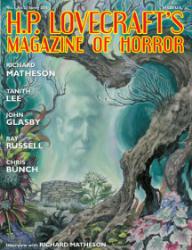
"Innsmouth Bane" John Glasby
"He Wanted to Live" Richard Matheson
"One Day at a Time" Charles Black
"My! What Big Teeth They Have" Melissa Kirkwood
"The Dark" R.J. Lewis
"A Ghost Can Be Born" Ray Russell
"Sweet As This" Joel McRennary
"Killing the Pain" Marc Bilgrey
"The Pride is Back" Jean Paiva
"I Who Am Nothing" Chris Bunch
"Where Does the Town Go At Night?" Tanith Lee
"My! What Big Teeth They Have" by Melissa Kirkwood is another short-short, this one with an amusing role reversal. A little girl in the playground is ambushed by a pedophile, late at night. It ends much better than it would have in real life.
"The Dark" by R.J. Lewis paints a familiar picture–a psychiatrist interviews a man, a night guard, who claims that there are things in the dark. Now that he’s seen those night creatures, they are out to get him. The plot is quite predictable, but there are a few genuinely creepy moments in this story–especially for those who are afraid of the dark.
"A Ghost Can Be Born" by Ray Russell starts as your normal ghost story–a man comes home, only to discover that he has a visitor, a friend he has not spoken to in a long while. They spend a pleasant evening, talking and drinking, until the friend disappears without a trace. There is no doubt that he was a ghost, but there is a slight problem–the friend is not dead. I was pleasantly surprised by this story. Instead of clichéd ghost fare, this turned into a sensitive and melancholy exploration of what makes a person what he is, and what ghosts are made of. A very good read.
"Sweet As This" by Joel McRennary starts out with a sweetshop owner who caters to the most rich and demanding clientele. The sweetshop owner soon meets a mysterious lady, whose demands challenge even his extraordinary skill–she asks him to sugarcoat live monarch butterflies. The descriptions of his confections are mouthwatering, and the writing sparkles and shines. The sequence with candied butterflies is especially delightful. I was even willing to forget that those things are poisonous. Unfortunately, the resolution that involved ancient cults and human sacrifices felt like a let down–I was expecting something more imaginative. Nonetheless, this story is well worth reading, especially the first half.
"The Pride is Back" by Jean Paiva describes a quiet rural town where a few people have recently gone missing. The protagonist, a frustrated writer who just returned back home, goes for a hike, and finds a beautiful house deep in the forest. The woman who greets him seems suspiciously friendly, but very attractive. Of course, she is more than she seems.
"I Who Am Nothing" by Chris Bunch is an allegorical tale of a boy in an unidentified country. The unnamed protagonist discovers that he has strange powers, which allow him to telekinetically kill those who would harm him, and hide in the resulting nothingness. This story is quite difficult to describe, since so much of it hinges on the atmosphere and the imagery. I enjoyed it very much.
"Where Does the Town Go At Night?" by Tanith Lee was the best story in this issue. Anton travels to a coastal town. The country remains unnamed, but it conjures an image of a small Scandinavian (or perhaps German) locale. It is a beautiful and quiet place, but Anton’s task is not a pleasant one: he is here to see Marthe, the woman he has had an affair with a few years ago. His illegitimate son, his well-hidden secret, is the reason for his visit. Before he goes to see Marthe, he runs into a beggar who tells him a wondrous tale: some nights, a part of the town detaches itself from the shore, and goes frolicking out in the sea. Everyone is asleep on such nights, except the select few, the Awake, who only remember these night travels as a dream. But while they are Awake, they see mermaids and bright fishes swimming among the flowers of the garden, and only bright seashells are left in the morning.